Perception of Child-Friendly Streets and Spatial Planning Responses in High-Density Cities Amidst Supply–Demand Disparities
Abstract
1. Introduction
1.1. Related Work
1.2. Research Objectives
2. Data and Methods
2.1. Study Area
2.2. Theoretical Framework
- (1)
- Data collection: Street view data for this study was sourced from Baidu Street View, covering the road network in the central urban area of Xiamen. A total of 14,870 sampling points were set every 50 m using ArcGIS 10.2, with panoramic photos taken at each point and cropped into four sections: 0°, 90°, 180°, and 270° (2560 × 1440 pixels, 24-bit depth). After excluding incomplete images, 44,002 images were used. The Street network and building vector data were sourced from OpenStreetMap https://www.openstreetmap.org/#map=6/46.45/2.21 (accessed on 3 January 2025) and verified using the latest satellite imagery and field survey data. For the Children’s Street-Level Child-Friendly Perception index, a formal survey was conducted from 20 March to 2 April 2025. Using the MEBS method, children selected images that matched provided descriptions, and ranking scores were generated based on their choices. The data from 200 children assessed five main indicators: safety, hygiene, education, entertainment, and child participation. These indicators were quantified based on children’s intuitive ratings. The TrueSkill algorithm was used for webpage ranking and scoring, which was integrated into tablet terminals to create an easy-to-use assessment system. In the competition module, children selected images based on descriptions, and the results were used to calculate ranking scores, with the average score determining the final child-friendliness rating. The CNN-BiLSTM model was then used to predict the remaining urban street images, and ArcGIS spatial analysis tools were applied to overlay the data, generating a quantified child-friendliness index. From 20 to 25 May 2025, seven experts scored the importance of each indicator, and the Analytic Hierarchy Process (AHP) was used to calculate the weight of each factor (CR = 0.08 < 0.1). Values were assigned to each factor based on children’s physical and psychological characteristics (Table 1).
- (2)
- Indicator computation: After pre-training, the TrueSkill/CNN-BiLSTM model was used to perform child-friendliness indicator perception calculation [42] quality and landscape perception metrics were extracted from images using HRNet and MATLAB R2023b. ArcMap 10.6 was then used to verify the autocorrelation between variables and spatial regions through spatial autocorrelation and hotspot analyses, ensuring result visibility and interpretability.
- (3)
- Data analysis: SHAP analysis and interaction value analysis further explored how different street environment factors influence children’s perceptions of child-friendliness. XGBoost is used to capture complex nonlinear relationships, analyzing how various environmental features impact child-friendliness, while GeoSHapley enhances the model’s spatial interpretability by calculating the marginal effects of variables on children’s perceptions of child-friendliness, clearly identifying the impact of different spatial locations on child-friendliness.
2.3. Variable Selection
| Indicator Category | Research Indicators | Child Applicability Indicator Explanation | Quantitative Methods | Weight |
|---|---|---|---|---|
| Supply | Child-Friendly Index (Safety, Hygiene, Education, Entertainment, Child Participation) | Child-Friendly Index for Urban Streets | TrueSkill/CNN-BiLSTM | 0.1175 |
| Openness | The proportion of sky features in the image, along with its openness, provides children with opportunities for exploration and engagement [34,43]. | HRNet | 0.0885 | |
| Greenness | Various vegetation features in an image, along with multi-level vegetation density, create a sense of depth for children [43]. | HRNet | 0.1315 | |
| Pavement coverage rate | The proportion of paved surfaces in the image meets the requirements for safe pedestrian access for children [34]. | HRNet | 0.1016 | |
| Enclosure | The proportion of enclosed elements in the image affects their sense of safety and exploration space [44,45]. | HRNet | 0.0828 | |
| Sidewalk | The proportion of sidewalk elements in the image impacts the safety and autonomy of children’s activities [34]. | HRNet | 0.1185 | |
| Fence rate | The proportion of fencing elements in the image affects children’s independent mobility and social interaction [46] | HRNet | 0.0958 | |
| Traffic flow | The proportion of motor vehicles in the image quantifies the varying threat weights different vehicle types pose to child pedestrian safety [44]. | HRNet | 0.1266 | |
| Color Complexity | The diversity of colors in images makes children more susceptible to color-related influences [47]. | MATLAB | 0.0655 | |
| Visual complexity | Image entropy values: Children are more susceptible to visual complexity factors [48] | MATLAB | 0.0717 | |
| Demand | Population density of children aged 0–14 | Expressed in terms of population per square kilometer, this directly reflects the demand of children [49]. | ArcGIS | 0.2594 |
| Number of cultural facilities | Cultural and educational venues support cognitive development, creativity, and social participation opportunities for children [50]. | ArcGIS | 0.2123 | |
| Number of medical facilities | Medical accessibility ensures timely healthcare, reducing parental safety concerns and improving the overall livability for children [51]. | ArcGIS | 0.2087 | |
| Number of Entertainment facilities | Entertainment facilities provide diverse play options that enhance children’s physical, emotional, and social development [52]. | ArcGIS | 0.0915 | |
| Number of Sports Facilities | Sports facilities promote physical exercise and peer interaction, contributing to children’s physical health and the development of teamwork skills [53]. | ArcGIS | 0.1116 | |
| Number of Scenic Spot Facilities | Scenic areas enrich children’s natural experiences and aesthetic needs [54]. | ArcGIS | 0.0392 | |
| Number of dining facilities | A wide variety of dining options are available, providing convenience for children’s travel needs [55]. | ArcGIS | 0.0773 |
2.4. Data Collection and Processing
2.4.1. MEBS-Based Perceptual Data Collection in Children
2.4.2. High-Resolution Networks for Semantic Segmentation (HRNet)
2.4.3. Image Computation Method Based on Matching Mechanism (TrueSkill) and Convolutional Neural Network-Bidirectional Long Short-Term Memory (CNN-BiLSTM) Prediction
2.4.4. MATLAB Visual Complexity and Color Complexity Calculation
2.4.5. Hotspot Analysis (Getis-Ord Gi*)
2.4.6. XGBoost-GeoSHapley Additive Explanation Model
3. Result
3.1. Child-Friendliness of Streets
3.2. Cluster Analysis of Child-Friendly Spaces in Urban Districts
3.3. Spatial Distribution of Child-Friendly Supply and Demand Levels
3.4. GeoSHapely Contribution Plots for XGBoost Model: Spatial Effects, Nonlinear Effects, and Interaction Effects
3.5. Nonlinear Marginal Effects
4. Discussion
4.1. Overall Child-Friendliness Level of Urban Streets
4.2. Mechanisms of How Different Street Elements Influence Child-Friendliness
4.3. Spatial Imbalance in Supply and Demand of Child-Friendly Urban Environments in Xiamen and Its Causes
4.4. Planning and Design Recommendations for Enhancing Child-Friendly Urban Street Environments and Spatial Planning Benefits
4.5. Research Contributions and Limitations
4.5.1. Research Contributions
4.5.2. Research Limitations
5. Conclusions
- (1)
- The research results show that children’s perceptions of friendliness show significant spatial variation, particularly in high-density areas, where supply and demand mismatch for facilities. GeoSpatial analysis reveals a north–south difference in perceptions, with higher population density in the southern part of Siming District, while the northern part of Huli District has lower development intensity. Despite high spatial contribution in the northeast and central regions, these areas have lower child population density, while higher density areas show lower supply–demand matching.
- (2)
- Further analysis shows that variables such as greening rate, pavement coverage rate, and openness contribute nonlinearly in the GeoSHapley model. Their interactions significantly affect children’s sense of safety and willingness to engage with the street space. This finding strengthens the theories of visual permeability and accessibility-perceived safety in environmental psychology and provides decision-making references for participatory micro-updates at the street level.
- (3)
- From a policy perspective, the research results offer evaluation tools and optimization paths for the localized implementation of the Child-Friendly City (CFC) framework, with great potential for application in urban renewal, old community renovation, and child participation mechanism design. The study supports the creation of a child-centered urban space evaluation system and emphasizes incorporating children into the daily planning process to address issues such as spatial compression and loss of activity spaces caused by urbanization.
- (4)
- The XGBoost-GeoSHapley framework is more capable of revealing the collaborative mechanisms of spatial variables than traditional models such as geographical detectors and geographically weighted regression. It improves explanatory transparency and resolves issues related to spatial feature interactions and geographical location contribution differences, which were challenging for previous models. Its interpretability advantage helps promote the shift from prediction-oriented to explanation- and operability-oriented spatial modeling.
- (5)
- Although this study has made significant progress in both theoretical and empirical aspects, there are some limitations. One key limitation is that the model’s application was based on cross-sectional data, which limits the ability to explore dynamic changes over time. Future research should incorporate longitudinal data to conduct dynamic analyses, exploring the trends in children’s perceptions of child-friendly environments. Additionally, cross-regional validation in different urban forms and cultural contexts will further test the applicability of this framework in various urban environments. Lastly, integrating deep participatory design methods and enhancing the linkage between the evaluation framework and real behavior data from children will make the framework more refined and comprehensive in practical applications.
Supplementary Materials
Author Contributions
Funding
Institutional Review Board Statement
Informed Consent Statement
Data Availability Statement
Acknowledgments
Conflicts of Interest
References
- Witten, K.; Kearns, R.; Carroll, P. Urban inclusion as wellbeing: Exploring children’s accounts of confronting diversity on inner city streets. Soc. Sci. Med. 2015, 133, 349–357. [Google Scholar] [CrossRef]
- Bringolf-Isler, B.; De Hoogh, K.; Schindler, C.; Kayser, B.; Suggs, L.S.; Dössegger, A.; Probst-Hensch, N.; Group, S.S. Sedentary behaviour in Swiss children and adolescents: Disentangling associations with the perceived and objectively measured environment. Int. J. Environ. Res. Public Health 2018, 15, 918. [Google Scholar] [CrossRef]
- Ergler, C.; Smith, K.; Kotsanas, C.; Hutchinson, C. What makes a good city in pre-schoolers’ eyes? Findings from participatory planning projects in Australia and New Zealand. J. Urban Des. 2015, 20, 461–478. [Google Scholar] [CrossRef]
- Chu, M.; Fang, Z.; Lee, C.-Y.; Shang-Kuan, C.-H.; Mao, L.; Chiang, Y.-C. Building a child-friendly social environment from the perspective of children in China based on focus group interviews. Curr. Psychol. 2025, 44, 2001–2017. [Google Scholar] [CrossRef]
- Sheng, K.; Liu, L.; Wang, F.; Li, S.; Zhou, X. An eye-tracking study on exploring children’s visual attention to streetscape elements. Buildings 2025, 15, 605. [Google Scholar] [CrossRef]
- Patel, J.; Katapally, T.R.; Khadilkar, A.; Bhawra, J. The interplay between air pollution, built environment, and physical activity: Perceptions of children and youth in rural and urban India. Health Place 2024, 85, 103167. [Google Scholar] [CrossRef]
- Taylor, M.P.; Camenzuli, D.; Kristensen, L.J.; Forbes, M.; Zahran, S. Environmental lead exposure risks associated with children’s outdoor playgrounds. Environ. Pollut. 2013, 178, 447–454. [Google Scholar] [CrossRef] [PubMed]
- Dong, W.; Liu, Y.; Bai, R.; Zhang, L.; Zhou, M. The prevalence and associated disability burden of mental disorders in children and adolescents in China: A systematic analysis of data from the Global Burden of Disease Study. Lancet Reg. Health–West. Pac. 2025, 55, 101486. [Google Scholar] [CrossRef] [PubMed]
- Zhang, M.; Nie, Q.; Ye, W.; Wang, Y.; Yang, Z.; Teng, Z. Longitudinal dynamic relationships between videogame use and symptoms of gaming disorder and depression among Chinese children and adolescents. J. Youth Adolesc. 2025, 54, 426–438. [Google Scholar] [CrossRef] [PubMed]
- Zhu, Y.; Zhang, G. Research on informal outdoor public space in cities for urban children based on the LBS big data. Mod. Urban Res. 2019, 1, 31–35. [Google Scholar]
- Zhai, B.; Zhu, W. Analysis on spatial-temporal characteristics of children’s outdoor activities in big cities: A case study of shanghai. City Plan Rev. 2018, 42, 87–96. [Google Scholar]
- Nations, U. Convention on the Rights of the Child; OHCHR: Geneva, Switzerland, 1989. [Google Scholar]
- Cordero-Vinueza, V.A.; Niekerk, F.F.; van Dijk, T.T. Making child-friendly cities: A socio-spatial literature review. Cities 2023, 137, 104248. [Google Scholar] [CrossRef]
- Palmas, S.; Beise, J.; George, T.; You, D. Advantage and paradox—Inequalities for children in urban settings. In Urban Inequalities: A Multidimensional and International Perspective; Springer: Berlin/Heidelberg, Germany, 2024; pp. 201–220. [Google Scholar]
- The UNICEF. Explore Child Friendly Cities Initiatives Around the World. 2024. Available online: https://www.unicef.org/childfriendlycities/initiatives?f%5B0%5D=local_terms_facet_2%3Af327a9d6-a3f6-4fd0-b6d4-712332911ee5#in-page-search (accessed on 19 May 2024).
- Nan, F. Policy innovation on building child friendly cities in China: Evidence from four Chinese cities. Child. Youth Serv. Rev. 2020, 118, 105491. [Google Scholar] [CrossRef]
- Gibson, J.J. The Ecological Approach to Visual Perception: Classic Edition; Psychology Press: Oxfordshire, UK, 2014. [Google Scholar]
- McLeod, S. Maslow’s hierarchy of needs. Simply Psychol. 2007, 1, 3–4. [Google Scholar]
- Simons, J.A.; Irwin, D.B.; Drinnien, B.A. Maslow’s hierarchy of needs. Psychol. Rev. 1987, 9, 222. [Google Scholar]
- Morán Uriel, J.; Camerin, F.; Córdoba Hernández, R. Urban Horizons in China: Challenges and Opportunities for Community Intervention in a Country Marked by the Heihe-Tengchong Line. In Diversity as Catalyst: Economic Growth and Urban Resilience in Global Cityscapes; Siew, G., Allam, Z., Cheshmehzangi, A., Eds.; Springer Nature: Singapore, 2024; pp. 105–125. [Google Scholar] [CrossRef]
- Bureau of Statistics. Xiamen Statistical Yearbook 2023. 2023. Available online: http://tjj.xm.gov.cn/tjzl/tjsj/tqnj/ (accessed on 19 May 2024).
- Wang, X.; Xiong, F.; Wang, Z.; Chen, S.; Zhang, Z.; Peng, L. Planning and layout of facilities for the elders based on POI and machine learning: A case study of Wuhan. Econ. Geogr. 2021, 41, 49–56. [Google Scholar]
- Tayefi Nasrabadi, M.; García, E.H.; Pourzakarya, M. Let children plan neighborhoods for a sustainable future: A sustainable child-friendly city approach. Local Environ. 2021, 26, 198–215. [Google Scholar] [CrossRef]
- Torres, J.; Cloutier, M.-S.; Bergeron, J.; St-Denis, A. ‘They installed a speed bump’: Children’s perceptions of traffic-calming measures around elementary schools. Child. Geogr. 2020, 18, 477–489. [Google Scholar] [CrossRef]
- D’Haese, S.; Vanwolleghem, G.; Hinckson, E.; De Bourdeaudhuij, I.; Deforche, B.; Van Dyck, D.; Cardon, G. Cross-continental comparison of the association between the physical environment and active transportation in children: A systematic review. Int. J. Behav. Nutr. Phys. Act. 2015, 12, 145. [Google Scholar] [CrossRef]
- Moore, K.A. Developing an indicator system to measure child well-being: Lessons learned over time. Child Indic. Res. 2020, 13, 729–739. [Google Scholar] [CrossRef]
- Wang, X.; Huang, J.; Qin, Z.; Gan, W.; He, Z.; Li, X. Is the Children’s 15-Minute City an Effective Framework for Enhancing Children’s Health and Well-Being? An Empirical Analysis from Western China. Buildings 2025, 15, 248. [Google Scholar] [CrossRef]
- Krishnamurthy, S. Reclaiming spaces: Child inclusive urban design. Cities Health 2019, 3, 86–98. [Google Scholar] [CrossRef]
- Van Vliet, W.; Karsten, L. Child-friendly cities in a globalizing world: Different approaches and a typology of children’s roles. Child. Youth Environ. 2015, 25, 1–15. [Google Scholar] [CrossRef]
- Oliver, M.; Witten, K.; Kearns, R.A.; Mavoa, S.; Badland, H.M.; Carroll, P.; Drumheller, C.; Tavae, N.; Asiasiga, L.; Jelley, S. Kids in the city study: Research design and methodology. BMC Public Health 2011, 11, 587. [Google Scholar] [CrossRef]
- Zhang, L.; Xu, X.; Guo, Y. The impact of a child-friendly design on children’s activities in urban community pocket parks. Sustainability 2023, 15, 10073. [Google Scholar] [CrossRef]
- Egli, V.; Villanueva, K.; Donnellan, N.; Mackay, L.; Forsyth, E.; Zinn, C.; Kytta, M.; Smith, M. Understanding children’s neighbourhood destinations: Presenting the Kids-PoND framework. Child. Geogr. 2020, 18, 420–434. [Google Scholar] [CrossRef]
- Zhou, Y.; Wang, M.; Lin, S.; Qian, C. Relationship between children’s independent activities and the built environment of outdoor activity space in residential neighborhoods: A case study of Nanjing. Int. J. Environ. Res. Public Health 2022, 19, 9860. [Google Scholar] [CrossRef] [PubMed]
- Yang, Y.; Wang, Q.; Wu, D.; Hang, T.; Ding, H.; Wu, Y.; Liu, Q. Constructing child-friendly cities: Comprehensive evaluation of street-level child-friendliness using the method of empathy-based stories, street view images, and deep learning. Cities 2024, 154, 105385. [Google Scholar] [CrossRef]
- Carroll, P.; Witten, K.; Kearns, R. Housing intensification in Auckland, New Zealand: Implications for children and families. Hous. Stud. 2011, 26, 353–367. [Google Scholar] [CrossRef]
- Kyttä, M. Children’s independent mobility in urban, small town, and rural environments. In Growing up in a Changing Urban Landscape; Van Gorcum: Gorinchem, The Netherlands, 1997; pp. 41–52. [Google Scholar]
- Ma, X.; Yang, J.; Zhang, R.; Yu, W.; Ren, J.; Xiao, X.; Xia, J. XGBoost-based analysis of the relationship between urban 2-D/3-D morphology and seasonal gradient land surface temperature. IEEE J. Sel. Top. Appl. Earth Obs. Remote Sens. 2024, 17, 4109–4124. [Google Scholar] [CrossRef]
- Chen, L.; Li, H.; Zhang, C.; Chu, W.; Corcoran, J.; Wang, T. Dynamic analysis of landscape drivers in the thermal environment of Guanzhong plain urban agglomeration. Int. J. Appl. Earth Obs. Geoinf. 2024, 134, 104239. [Google Scholar] [CrossRef]
- Zhao, J.; Guo, F.; Zhang, H.; Dong, J. Mechanisms of non-stationary influence of urban form on the diurnal thermal environment based on machine learning and MGWR analysis. Sustain. Cities Soc. 2024, 101, 105194. [Google Scholar] [CrossRef]
- Li, Z. Extracting spatial effects from machine learning model using local interpretation method: An example of SHAP and XGBoost. Comput. Environ. Urban Syst. 2022, 96, 101845. [Google Scholar] [CrossRef]
- Li, H.; Chen, C.; Yuan, Y.; Xia, X.; Huang, Q.; Ye, L.; Huang, Z. Equity analysis of bus network balance from the perspective of spatial morphology and service capability. Sci. Rep. 2025, 15, 2339. [Google Scholar] [CrossRef]
- Allouche, O.; Tsoar, A.; Kadmon, R. Assessing the accuracy of species distribution models: Prevalence, kappa and the true skill statistic (TSS). J. Appl. Ecol. 2006, 43, 1223–1232. [Google Scholar] [CrossRef]
- Hartig, T.; Korpela, K.; Evans, G.W.; Gärling, T. A measure of restorative quality in environments. Scand. Hous. Plan. Res. 1997, 14, 175–194. [Google Scholar] [CrossRef]
- Broberg, A.; Kyttä, M.; Fagerholm, N. Child-friendly urban structures: Bullerby revisited. J. Environ. Psychol. 2013, 35, 110–120. [Google Scholar] [CrossRef]
- Benjamin-Neelon, S.E.; Platt, A.; Bacardi-Gascon, M.; Armstrong, S.; Neelon, B.; Jimenez-Cruz, A. Greenspace, physical activity, and BMI in children from two cities in northern Mexico. Prev. Med. Rep. 2019, 14, 100870. [Google Scholar] [CrossRef] [PubMed]
- Rooney, T. Higher stakes–The hidden risks of school security fences for children’s learning environments. Environ. Educ. Res. 2015, 21, 885–898. [Google Scholar] [CrossRef]
- Leung, K.Y.; Loo, B.P. Determinants of children’s active travel to school: A case study in Hong Kong. Travel Behav. Soc. 2020, 21, 79–89. [Google Scholar] [CrossRef]
- Wang, R.; Cao, M.; Yao, Y.; Wu, W. The inequalities of different dimensions of visible street urban green space provision: A machine learning approach. Land Use Policy 2022, 123, 106410. [Google Scholar] [CrossRef]
- Yang, Y.; Jiang, L.; Ma, X.; Liu, S.; Wang, L. A Comprehensive Approach to Identifying the Supply and Demand of Urban Park Cultural Ecosystem Services in the Megalopolis Area of Shanghai, China. Land 2025, 14, 455. [Google Scholar] [CrossRef]
- Pang, R.; Xiao, J.; Yang, J.; Sun, W. Spatial Distribution Characteristics and Influencing Factors of Public Service Facilities for Children—A Case Study of the Central Urban Area of Shenyang. Land 2025, 14, 1485. [Google Scholar] [CrossRef]
- Lilford, R.J.; Daniels, B.; McPake, B.; Bhutta, Z.A.; Mash, R.; Griffiths, F.; Omigbodun, A.; Pinto, E.P.; Jain, R.; Asiki, G. Supply-side and demand-side factors affecting allopathic primary care service delivery in low-income and middle-income country cities. Lancet Glob. Health 2025, 13, e942–e953. [Google Scholar] [CrossRef] [PubMed]
- Bao, K.; Wu, S.; Oubibi, M.; Cai, L. Internet Gaming Disorder Among Rural Left-Behind Children in China: A Sociological Qualitative Study. Psychol. Res. Behav. Manag. 2025, 18, 387–403. [Google Scholar] [CrossRef]
- Li, Z.; Xie, S.; Chen, W. The influence of environment on adolescents’ physical exercise behavior based on family community and school micro-systems. Sci. Rep. 2025, 15, 12024. [Google Scholar] [CrossRef]
- Liu, W.; Wang, W. A Study on the Assessment of Tour–Art–Learning Quality in Urban Parks from a Child-Friendly Perspective: A Case Study of Shaheyuan Park in Chengdu. Sustainability 2025, 17, 684. [Google Scholar] [CrossRef]
- Altıntepe, B.; Altay, B. Restaurant inclusivity: Parents’ and children’s perspectives. Int. J. Hosp. Manag. 2025, 128, 104153. [Google Scholar] [CrossRef]
- Hart, R.; Wridt, P.; Giusti, D. The Child Friendly Community Assessment Tools. In A Facilitator’s Guide to the Local Assessment of Children’s Rights; UNICEF (Innocenti Research Centre): Florence, Italy; Childwatch International: Oslo, Norway, 2011. [Google Scholar]
- Taechaboonsermsak, S.P. Factors affecting the capabilities of family development centre staff regarding promotion of pre-school language learning amongst parents in Thailand Warunsicha Supprasert, Piyatida Khajornchaikul, Kitiphong Harncharoen, Pimsurang. J. Health Res. 2019, 33, 43–56. [Google Scholar]
- Vijay, N.C.; Rokade, S.; Bivina, G. Towards safer streets: A review of child pedestrian behavior and safety worldwide. Transp. Res. Part F Traffic Psychol. Behav. 2024, 103, 638–660. [Google Scholar] [CrossRef]
- Adams, S.; Savahl, S.; Florence, M.; Jackson, K. Considering the natural environment in the creation of child-friendly cities: Implications for children’s subjective well-being. Child Indic. Res. 2019, 12, 545–567. [Google Scholar] [CrossRef]
- Carroll, P.; Witten, K.; Kearns, R.; Donovan, P. Kids in the City: Children’s use and experiences of urban neighbourhoods in Auckland, New Zealand. J. Urban Des. 2015, 20, 417–436. [Google Scholar] [CrossRef]
- Eyler, A.A.; Brownson, R.C.; Doescher, M.P.; Evenson, K.R.; Fesperman, C.E.; Litt, J.S.; Pluto, D.; Steinman, L.E.; Terpstra, J.L.; Troped, P.J. Policies related to active transport to and from school: A multisite case study. Health Educ. Res. 2008, 23, 963–975. [Google Scholar] [CrossRef] [PubMed]
- Haikkola, L.; Pacilli, M.G.; Horelli, L.; Prezza, M. Interpretations of urban child-friendliness: A comparative study of two neighborhoods in Helsinki and Rome. Child. Youth Environ. 2007, 17, 319–351. [Google Scholar] [CrossRef]
- Buczyłowska, D.; Zhao, T.; Singh, N.; Jurczak, A.; Siry, A.; Markevych, I. Exposure to greenspace and bluespace and cognitive functioning in children–a systematic review. Environ. Res. 2023, 222, 115340. [Google Scholar] [CrossRef] [PubMed]
- Malone, K. “The future lies in our hands”: Children as researchers and environmental change agents in designing a child-friendly neighbourhood. Local Environ. 2013, 18, 372–395. [Google Scholar] [CrossRef]
- Kemple, K.M.; Oh, J.; Kenney, E.; Smith-Bonahue, T. The power of outdoor play and play in natural environments. Child. Educ. 2016, 92, 446–454. [Google Scholar] [CrossRef]
- Qiu, L.; Zhu, X. Housing and community environments vs. independent mobility: Roles in promoting children’s independent travel and unsupervised outdoor play. Int. J. Environ. Res. Public Health 2021, 18, 2132. [Google Scholar] [CrossRef]
- De Visscher, S.; Bouverne-De Bie, M. Recognizing Urban Public Space as a Co-Educator: Children’s Socialization in Ghent. Int. J. Urban Reg. Res. 2008, 32, 604–616. [Google Scholar] [CrossRef]
- Bodén, L. On, to, with, for, by: Ethics and children in research. Child. Geogr. 2021, 1–16. [Google Scholar] [CrossRef]
- Kanuri, V.K.; Hughes, C.; Hodges, B.T. Standing out from the crowd: When and why color complexity in social media images increases user engagement. Int. J. Res. Mark. 2024, 41, 174–193. [Google Scholar] [CrossRef]
- Shu, X.; Mesimäki, M.; Kotze, D.J.; Wales, M.; Xie, L.; Benicke, R.; Lehvävirta, S. Needs and expectations of German and Chinese children for livable urban green spaces revealed by the method of empathy-based stories. Urban For. Urban Green. 2022, 68, 127476. [Google Scholar] [CrossRef]
- Posti-Ahokas, H. Empathy-based stories capturing the voice of female secondary school students in Tanzania. Int. J. Qual. Stud. Educ. 2013, 26, 1277–1292. [Google Scholar] [CrossRef]
- Särkelä, E.; Suoranta, J. The method of empathy-based stories as a tool for research and teaching. Qual. Rep. 2020, 25, 399–415. [Google Scholar] [CrossRef]
- Zhou, Y.; Xiong, Y. The influence of civil society’s economic status on environmental protection behaviors from the perspective of environmental sociology. Sci. Rep. 2025, 15, 24137. [Google Scholar] [CrossRef]
- Wu, C.; Ye, Y.; Gao, F.; Ye, X. Using street view images to examine the association between human perceptions of locale and urban vitality in Shenzhen, China. Sustain. Cities Soc. 2023, 88, 104291. [Google Scholar] [CrossRef]
- Minka, T.; Cleven, R.; Zaykov, Y. Trueskill 2: An Improved Bayesian Skill Rating System; Technical Report Number MSR-TR-2018-8; Microsoft Research: Redmond, WA, USA, 2018. [Google Scholar]
- Zhou, B.; Xu, S.; Yang, X.-X. Computing the color complexity of images. In Proceedings of the 2015 12th International Conference on Fuzzy Systems and Knowledge Discovery (FSKD), Zhangjiajie, China, 15–17 August 2015; pp. 1898–1902. [Google Scholar]
- Qiu, Y.; Liu, Y.; Liu, Y.; Li, Z. Exploring the linkage between the neighborhood environment and mental health in Guangzhou, China. Int. J. Environ. Res. Public Health 2019, 16, 3206. [Google Scholar] [CrossRef]
- Kumari, P.; Toshniwal, D. Extreme gradient boosting and deep neural network based ensemble learning approach to forecast hourly solar irradiance. J. Clean. Prod. 2021, 279, 123285. [Google Scholar] [CrossRef]
- Yang, C.; Zeng, W.; Yang, X. Coupling coordination evaluation and sustainable development pattern of geo-ecological environment and urbanization in Chongqing municipality, China. Sustain. Cities Soc. 2020, 61, 102271. [Google Scholar] [CrossRef]
- Li, Z. GeoShapley: A game theory approach to measuring spatial effects in machine learning models. Ann. Am. Assoc. Geogr. 2024, 114, 1365–1385. [Google Scholar] [CrossRef]
- Tapiro, H.; Oron-Gilad, T.; Parmet, Y. Pedestrian distraction: The effects of road environment complexity and age on pedestrian’s visual attention and crossing behavior. J. Saf. Res. 2020, 72, 101–109. [Google Scholar] [CrossRef] [PubMed]
- Zhong, Q.; Li, B.; Chen, Y. How do different urban footpath environments affect the jogging preferences of residents of different genders? Empirical research based on trajectory data. Int. J. Environ. Res. Public Health 2022, 19, 14372. [Google Scholar] [CrossRef] [PubMed]
- Sreetheran, M.; Van Den Bosch, C.C.K. A socio-ecological exploration of fear of crime in urban green spaces–A systematic review. Urban For. Urban Green. 2014, 13, 1–18. [Google Scholar] [CrossRef]
- Kim, S.; Woo, A. Streetscape and business survival: Examining the impact of walkable environments on the survival of restaurant businesses in commercial areas based on street view images. J. Transp. Geogr. 2022, 105, 103480. [Google Scholar] [CrossRef]
- Wang, R.; Lu, Y.; Zhang, J.; Liu, P.; Yao, Y.; Liu, Y. The relationship between visual enclosure for neighbourhood street walkability and elders’ mental health in China: Using street view images. J. Transp. Health 2019, 13, 90–102. [Google Scholar] [CrossRef]
- Fu, Y.; Wang, S. Constructing an evaluation framework for child-friendly city: A case study of outdoor recreation spaces in Shenyang City, China. J. Asian Archit. Build. Eng. 2025, 1–22. [Google Scholar] [CrossRef]
- McAllister, C. Child friendly cities and land use planning: Implications for children’s health. Environments 2008, 35, 45. [Google Scholar]
- Echendu, A.J. Urban planners’ perspectives of public participation in planning in Nigeria. SN Soc. Sci. 2023, 3, 33. [Google Scholar] [CrossRef]
- Creutzig, F.; Javaid, A.; Soomauroo, Z.; Lohrey, S.; Milojevic-Dupont, N.; Ramakrishnan, A.; Sethi, M.; Liu, L.; Niamir, L.; Bren d’Amour, C. Fair street space allocation: Ethical principles and empirical insights. Transp. Rev. 2020, 40, 711–733. [Google Scholar] [CrossRef]
- Pawlikowska-Piechotka, A. Child-friendly urban environment and playgrounds in Warsaw. Open House Int. 2011, 36, 98–110. [Google Scholar] [CrossRef]
- Deng, M.; Yang, W.; Chen, C.; Liu, C. Exploring associations between streetscape factors and crime behaviors using Google Street View images. Front. Comput. Sci. 2022, 16, 164316. [Google Scholar] [CrossRef]
- Nasar, J.L. Urban design aesthetics: The evaluative qualities of building exteriors. Environ. Behav. 1994, 26, 377–401. [Google Scholar] [CrossRef]
- Yu, Y.; Huang, G.; Sun, D.; Lyu, M.; Bart, D. Exploring the Impact of Waterfront Street Environments on Human Perception. Buildings 2025, 15, 1678. [Google Scholar] [CrossRef]
- Wang, L.; Han, X.; He, J.; Jung, T. Measuring residents’ perceptions of city streets to inform better street planning through deep learning and space syntax. ISPRS J. Photogramm. Remote Sens. 2022, 190, 215–230. [Google Scholar] [CrossRef]
- Yuan, Y.; Ye, L.H.; Li, H.; Huang, Z.C.; Chen, C.; Xia, X.H.; Huang, Q.Y. Analysis of Spatial Patterns and Urban Road. In Proceedings of the Second Global Forum on Space Information for Sustainable Development: GFSISD 2024, Guangzhou, China, 25–28 September 2024; Springer Nature: Berlin/Heidelberg, Germany, 2024; p. 129. [Google Scholar]
- Zhang, T.; Foliente, G.; Xiao, J.; Tang, L. Exploring the driving factors of land use change and spatial distribution in coastal cities: A case study of Xiamen city. Sustainability 2025, 17, 941. [Google Scholar] [CrossRef]
- Xiong, R.; Zhao, H.; Huang, Y. Spatial heterogeneity in the effects of built environments on walking distance for the elderly living in a mountainous city. Travel Behav. Soc. 2024, 34, 100693. [Google Scholar] [CrossRef]
- GB 50420-2007; Code for Design Specifications for Urban Green Spaces. Ministry of Construction of the People’s Republic of China: Beijing, China, 2007.
- Gori, M.; Chilosi, A.; Forli, F.; Burr, D. Audio-visual temporal perception in children with restored hearing. Neuropsychologia 2017, 99, 350–359. [Google Scholar] [CrossRef]
- Detrick, S. The origins, development and significance of the United Nations Convention on the Rights of the Child. In Proceedings of the United Nations Convention on the Rights of the Child, New York, NY, USA, 20 November 1989; pp. 19–30. [Google Scholar]

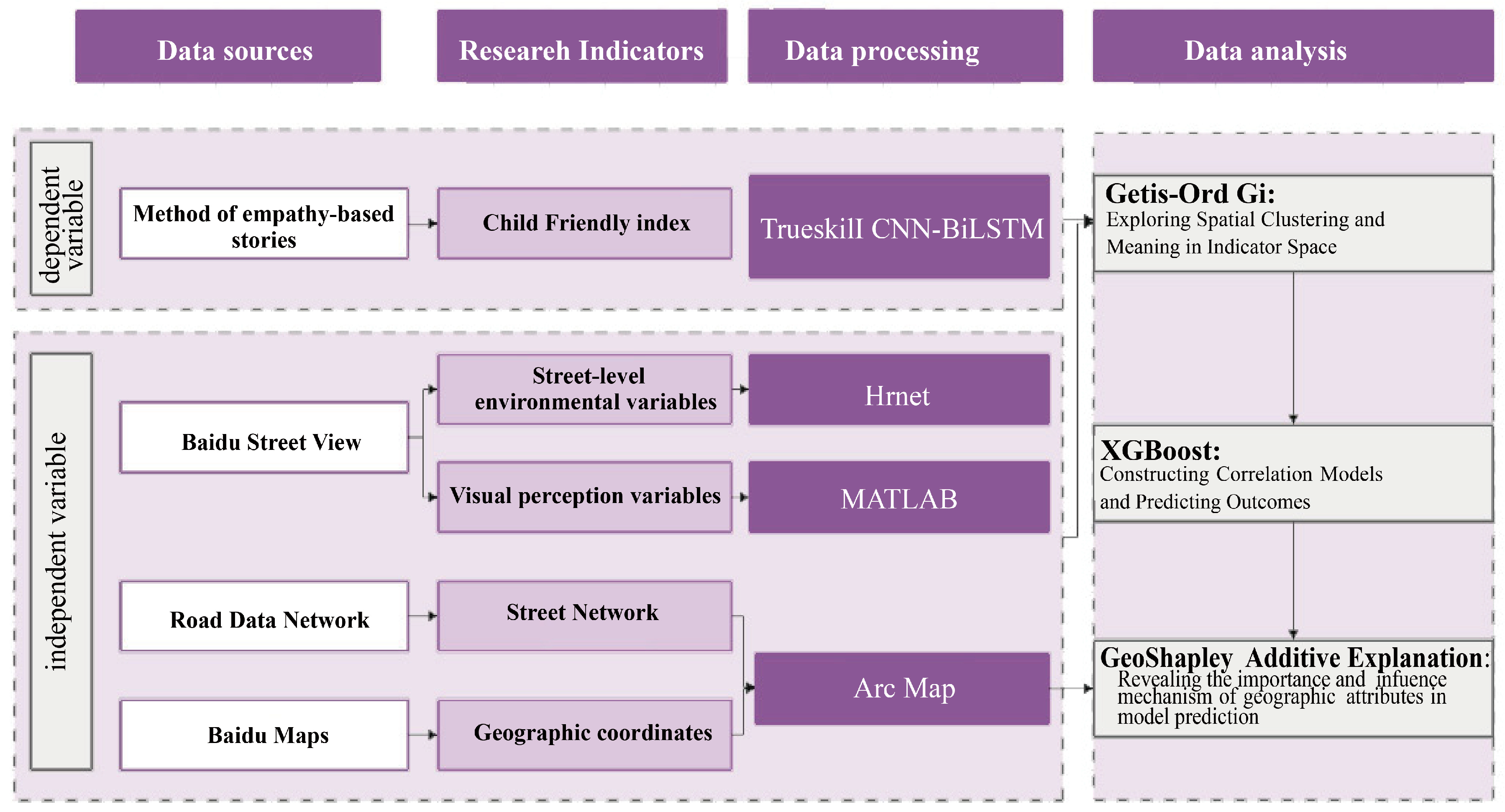

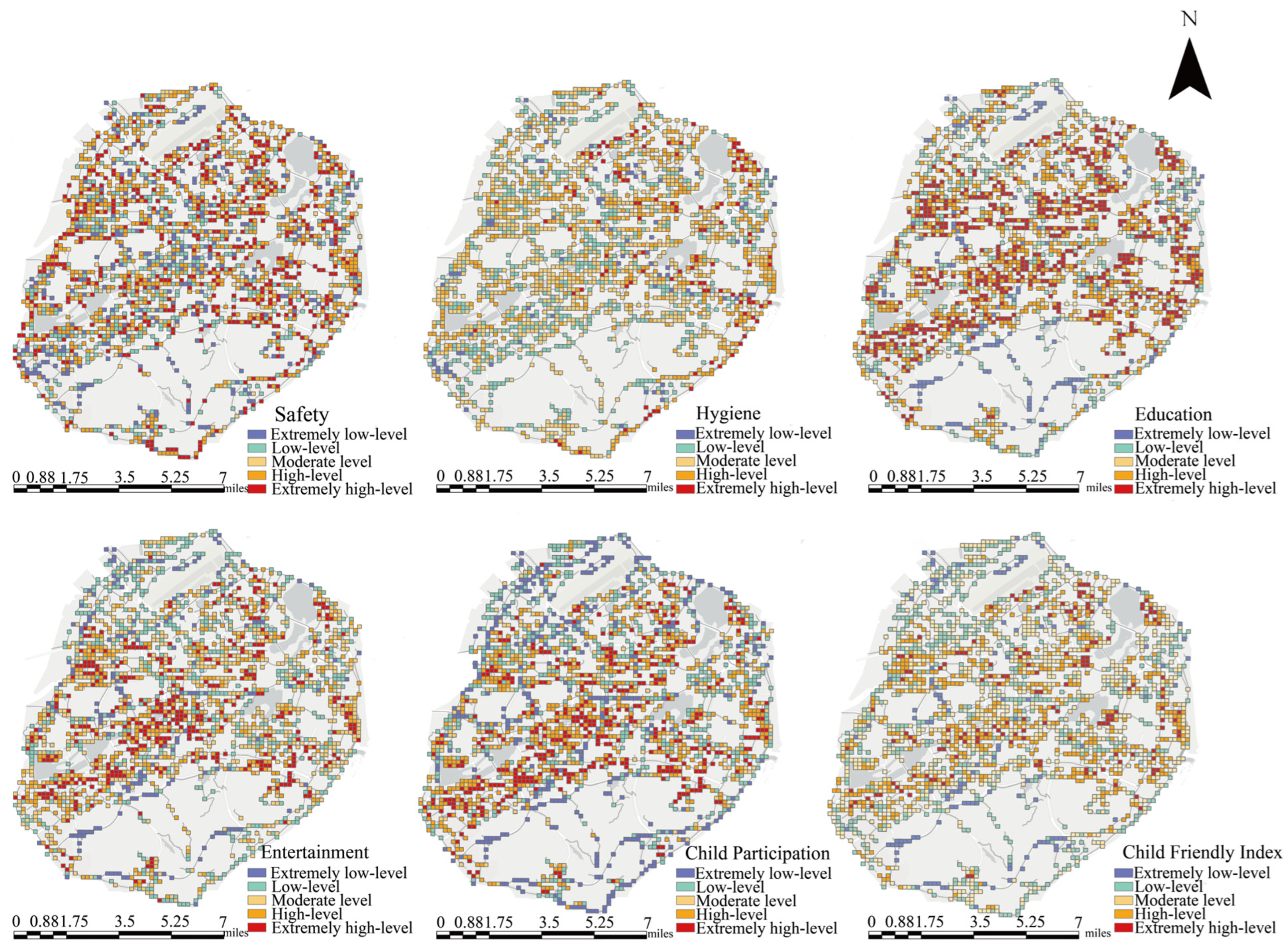
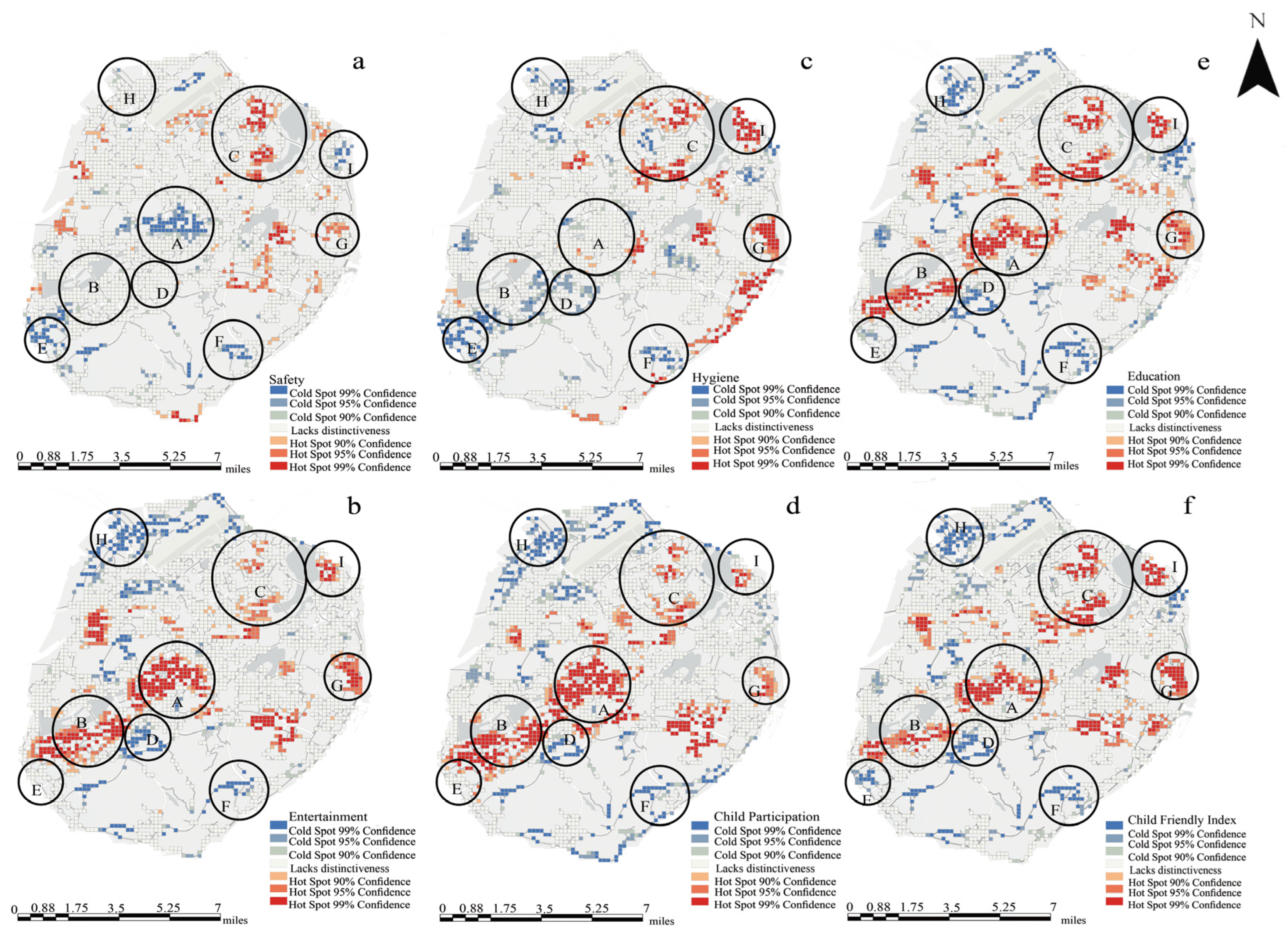
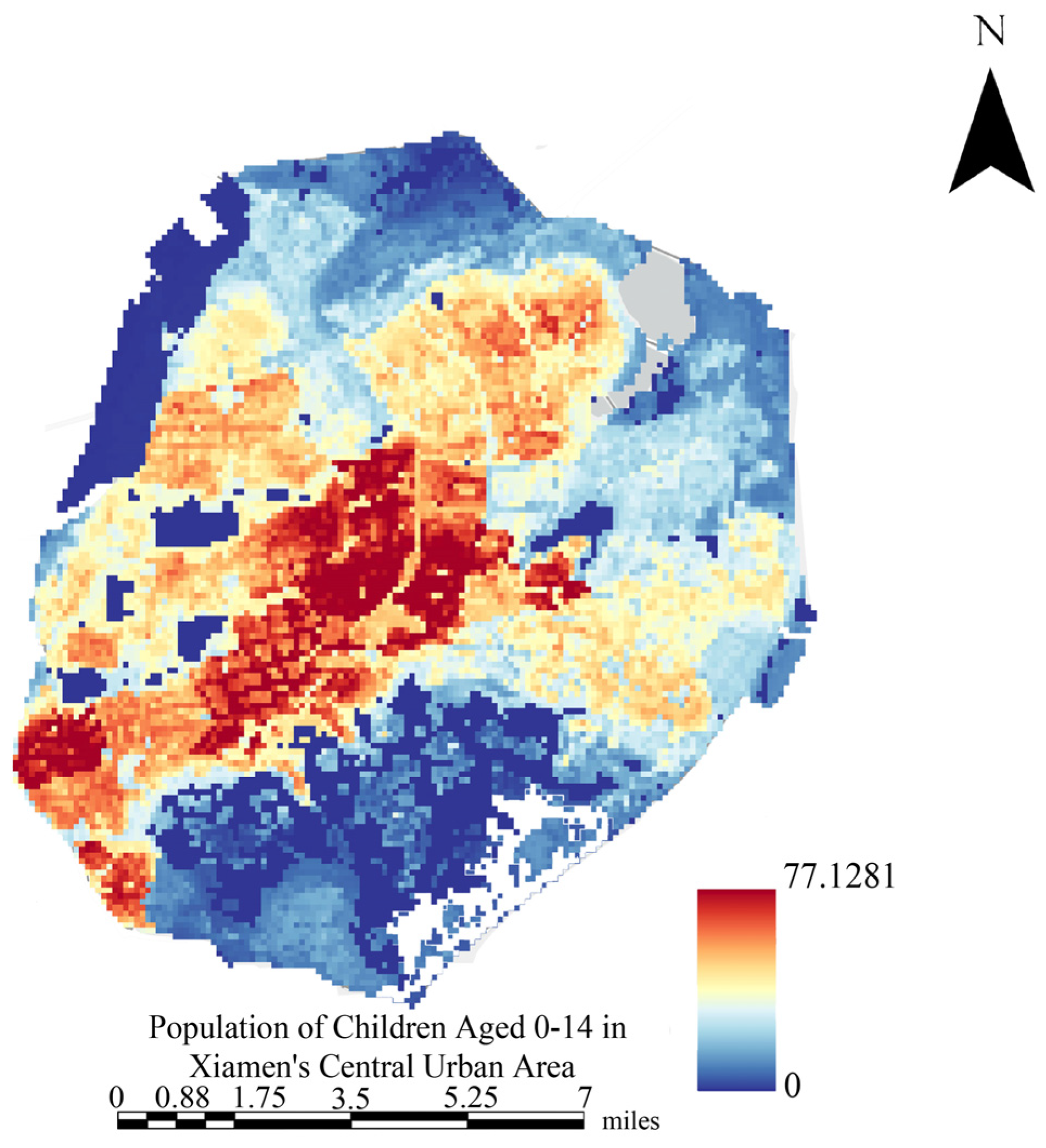
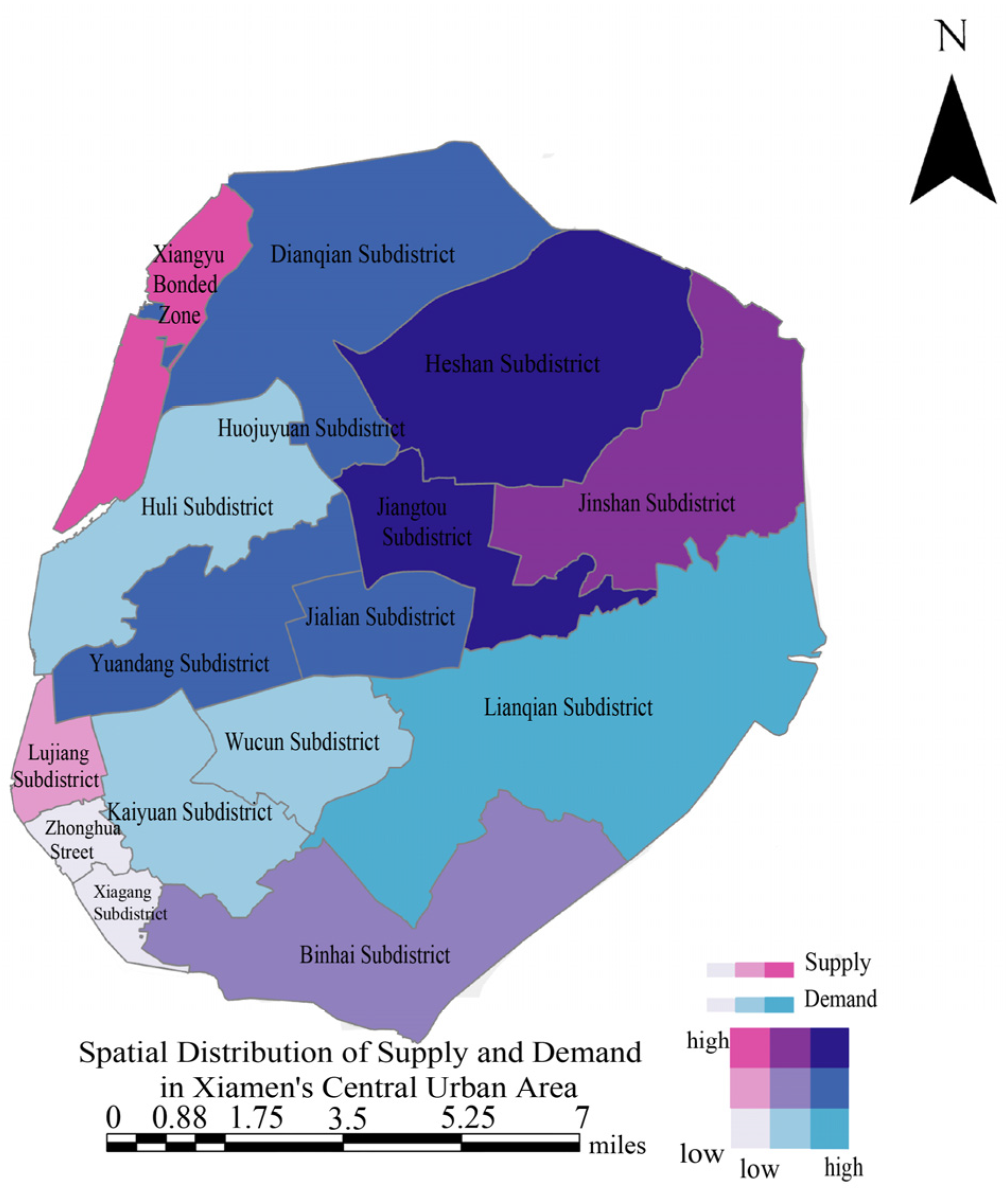
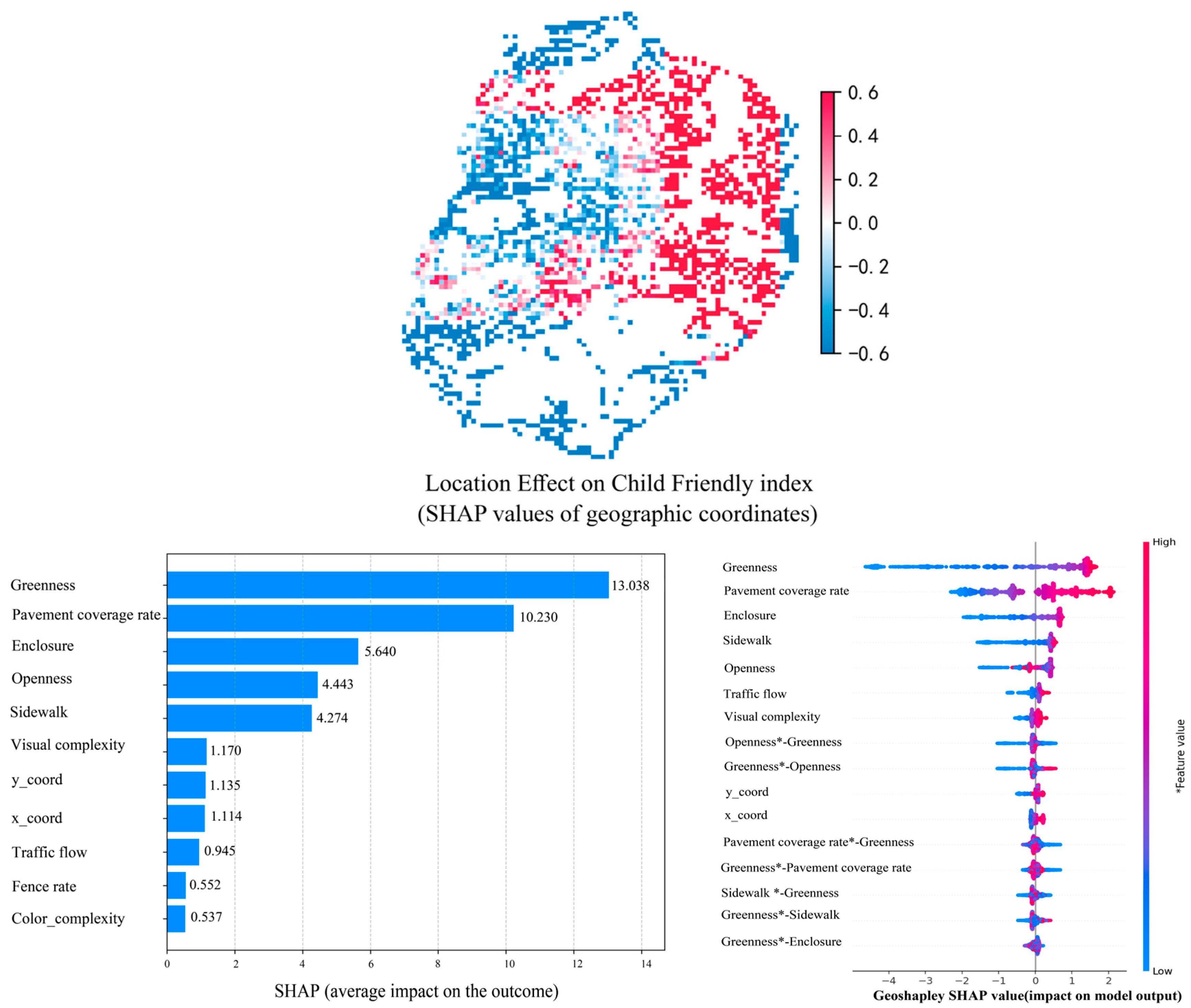
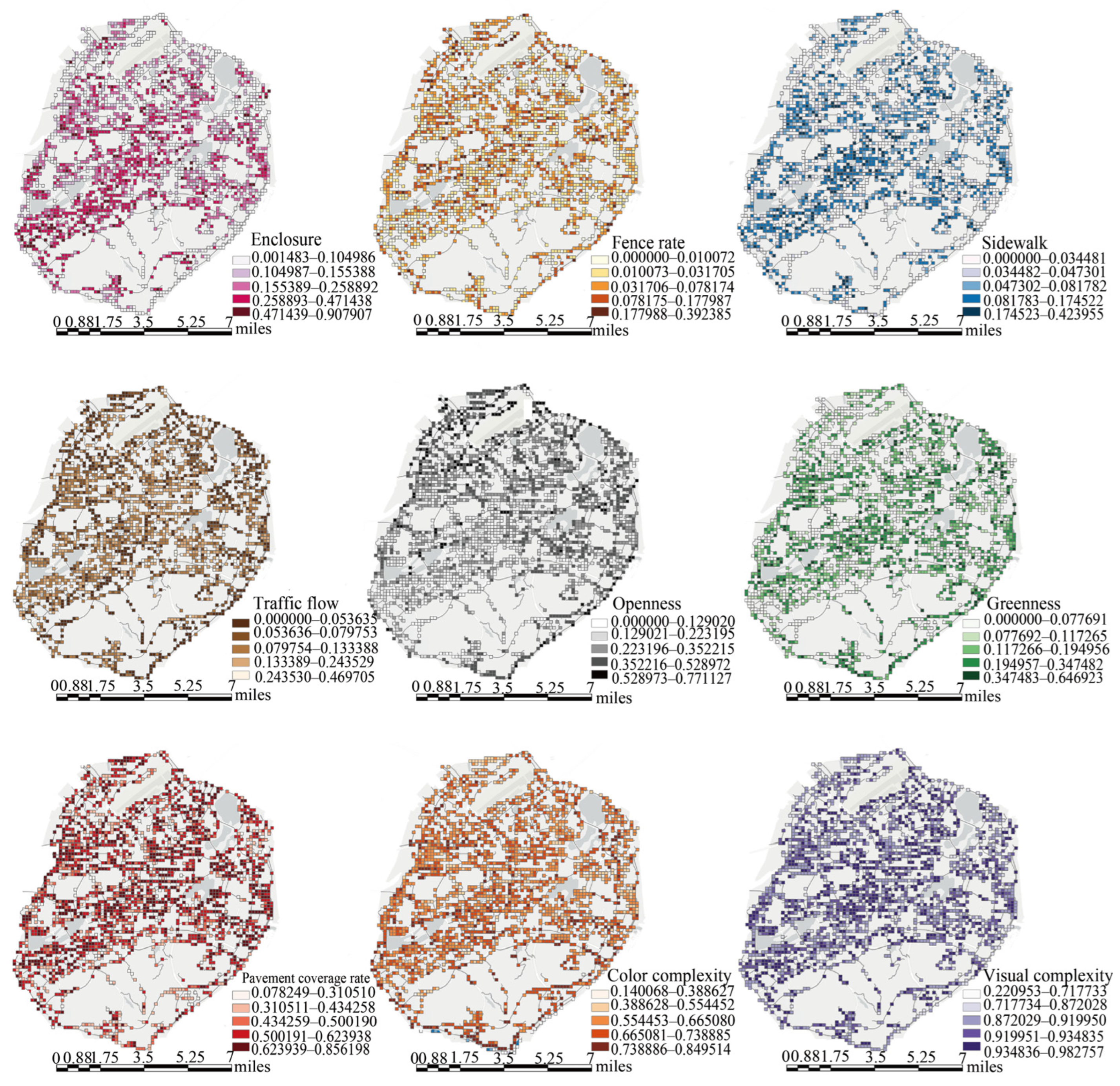
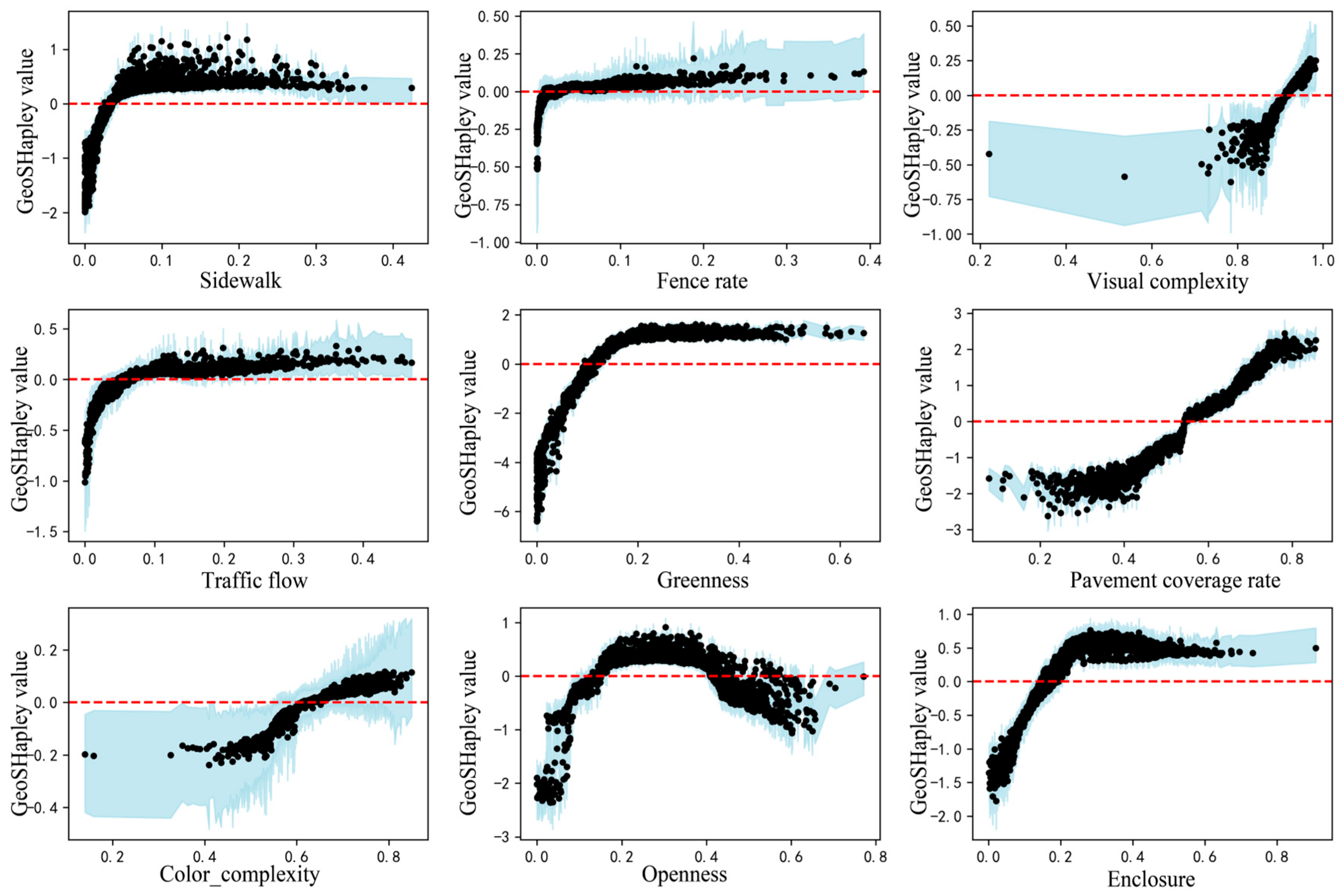
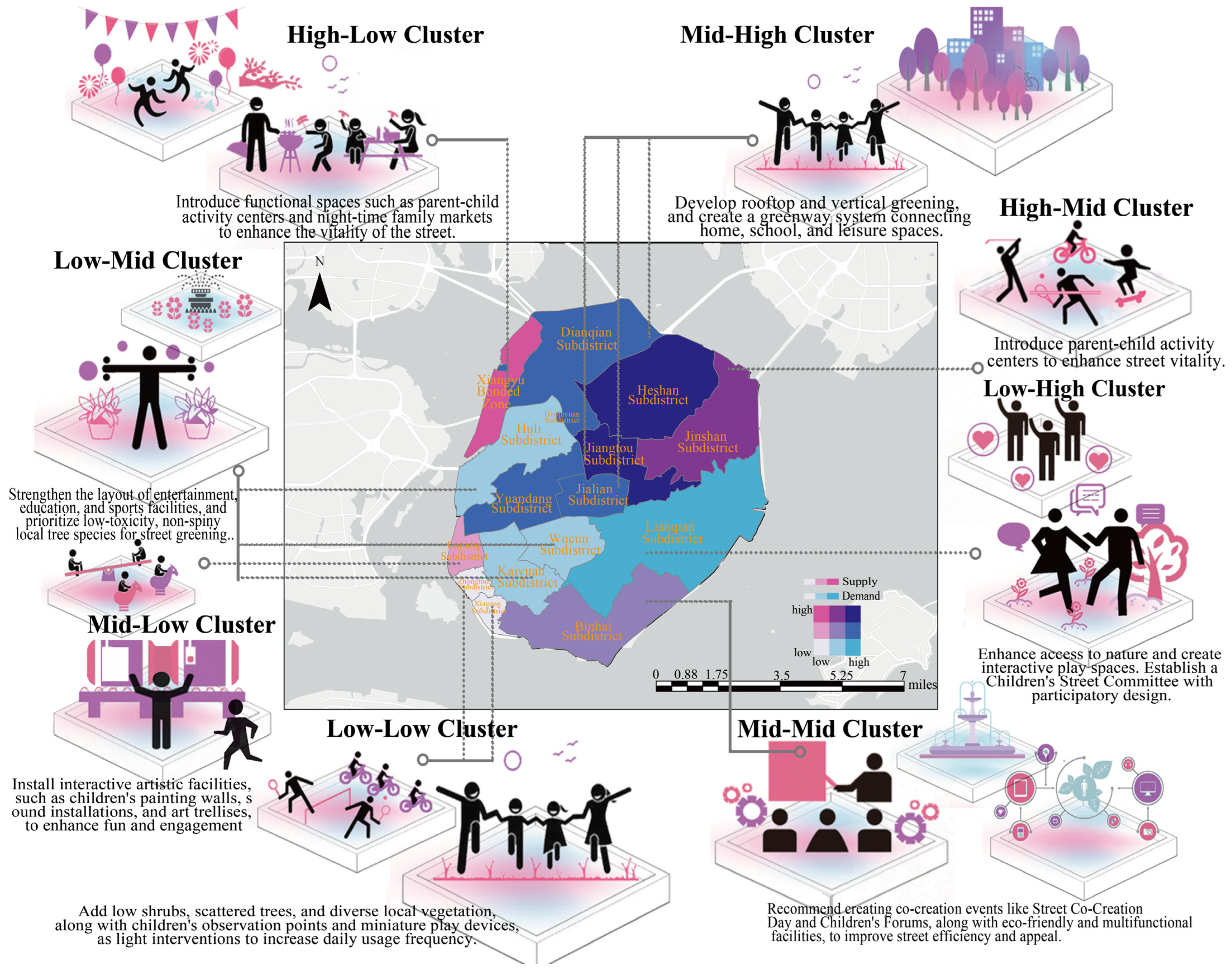
| Dimension | Question | Answer 1 | Answer 2 |
|---|---|---|---|
| Safety | Hey kids! Which of these options better meets the requirements for a safe play area and will help Nezha to successfully complete his first patrol mission? | This area is flat and free of hazards, ensuring that children can play safely and meeting Nezha’s safety inspection standards. | There are construction barriers in place here, and the ground is uneven. Take care when playing to avoid tripping up or bumping into things. |
| Hygiene | Nezha is searching for the perfect spot to build his secret hideout. It must have fresh air, plenty of sunlight, and be clean. Which of the locations shown in the pictures is more suitable? | This clean, green space is especially comfortable for children to rest in. | This place is covered in rubbish and dead leaves, which makes it unpleasant to look at. |
| Entertainment | Hey kids! Nezha and Ao Bing have agreed to find a place to play together. Can you help them pick which picture shows the spot that’s more suitable? | Here you’ll find climbing frames, bumper cars, and a wide variety of other activities. Children can have a wonderful time here, and the entertainment area meets all of Nezha’s inspection requirements. | I find this place boring. |
| Education | Hey kids! Master Taiyi told Nezha and Ao Bing to seek new knowledge, and now they’re searching for places to discover it! Which card contains the knowledge you want to learn? Pick one! | These are mobile bookcases and knowledge display stands. This is some of what I would like to know. | I don’t want to know anything here. |
| Child Participation | Hey kids! Nezha and Ao Bing are searching for a place where they can work with their friends. Choose the best option! | I find this place fascinating! | I find this place boring. |
| Statistical Indicator | Safety | Hygiene | Education | Entertainment | Child Participation |
|---|---|---|---|---|---|
| Cronbach’s Alphas | 0.784 | 0.754 | 0.726 | 0.725 | 0.752 |
| KMO value | 0.748 | ||||
| Approximate chi-square | 747.062 | ||||
| DF | 15 | ||||
| p value | 0.000 *** | ||||
| R2 | MAE | RMSE | |
|---|---|---|---|
| Safety | 0.806 | 0.856 | 1.14 |
| Hygiene | 0.876 | 0.873 | 1.05 |
| Education | 0.906 | 0.910 | 0.97 |
| Entertainment | 0.856 | 0.883 | 1.10 |
| Child Participation | 0.873 | 0.860 | 0.97 |
| Street Level | Safety | Hygiene | Education | Entertainment | Child Participation | Child-Friendly Index |
|---|---|---|---|---|---|---|
| Extremely High-Level streets | 42.85% | 26.32% | 50.31% | 48.75% | 47.41% | 20.41% |
| High-Level streets | 21.93% | 4.32% | 20.42% | 11.21% | 21.53% | 1.19% |
| Medium-Level streets | 7.42% | 33.45% | 5.62% | 0.53% | 3.57% | 27.40% |
| Low-Level streets | 4.68% | 21.79% | 11.04% | 34.23% | 2.07% | 40.46% |
| Extremely Low-Level streets | 23.12% | 14.27% | 12.61% | 5.28% | 25.42% | 10.54% |
Disclaimer/Publisher’s Note: The statements, opinions and data contained in all publications are solely those of the individual author(s) and contributor(s) and not of MDPI and/or the editor(s). MDPI and/or the editor(s) disclaim responsibility for any injury to people or property resulting from any ideas, methods, instructions or products referred to in the content. |
© 2025 by the authors. Licensee MDPI, Basel, Switzerland. This article is an open access article distributed under the terms and conditions of the Creative Commons Attribution (CC BY) license (https://creativecommons.org/licenses/by/4.0/).
Share and Cite
Su, C.; Cheng, Y.; Chen, S.; Li, W.; Nie, K.; Ding, Z. Perception of Child-Friendly Streets and Spatial Planning Responses in High-Density Cities Amidst Supply–Demand Disparities. Buildings 2025, 15, 3908. https://doi.org/10.3390/buildings15213908
Su C, Cheng Y, Chen S, Li W, Nie K, Ding Z. Perception of Child-Friendly Streets and Spatial Planning Responses in High-Density Cities Amidst Supply–Demand Disparities. Buildings. 2025; 15(21):3908. https://doi.org/10.3390/buildings15213908
Chicago/Turabian StyleSu, Chenxi, Yuxuan Cheng, Shaofeng Chen, Wenting Li, Kaining Nie, and Zheng Ding. 2025. "Perception of Child-Friendly Streets and Spatial Planning Responses in High-Density Cities Amidst Supply–Demand Disparities" Buildings 15, no. 21: 3908. https://doi.org/10.3390/buildings15213908
APA StyleSu, C., Cheng, Y., Chen, S., Li, W., Nie, K., & Ding, Z. (2025). Perception of Child-Friendly Streets and Spatial Planning Responses in High-Density Cities Amidst Supply–Demand Disparities. Buildings, 15(21), 3908. https://doi.org/10.3390/buildings15213908





